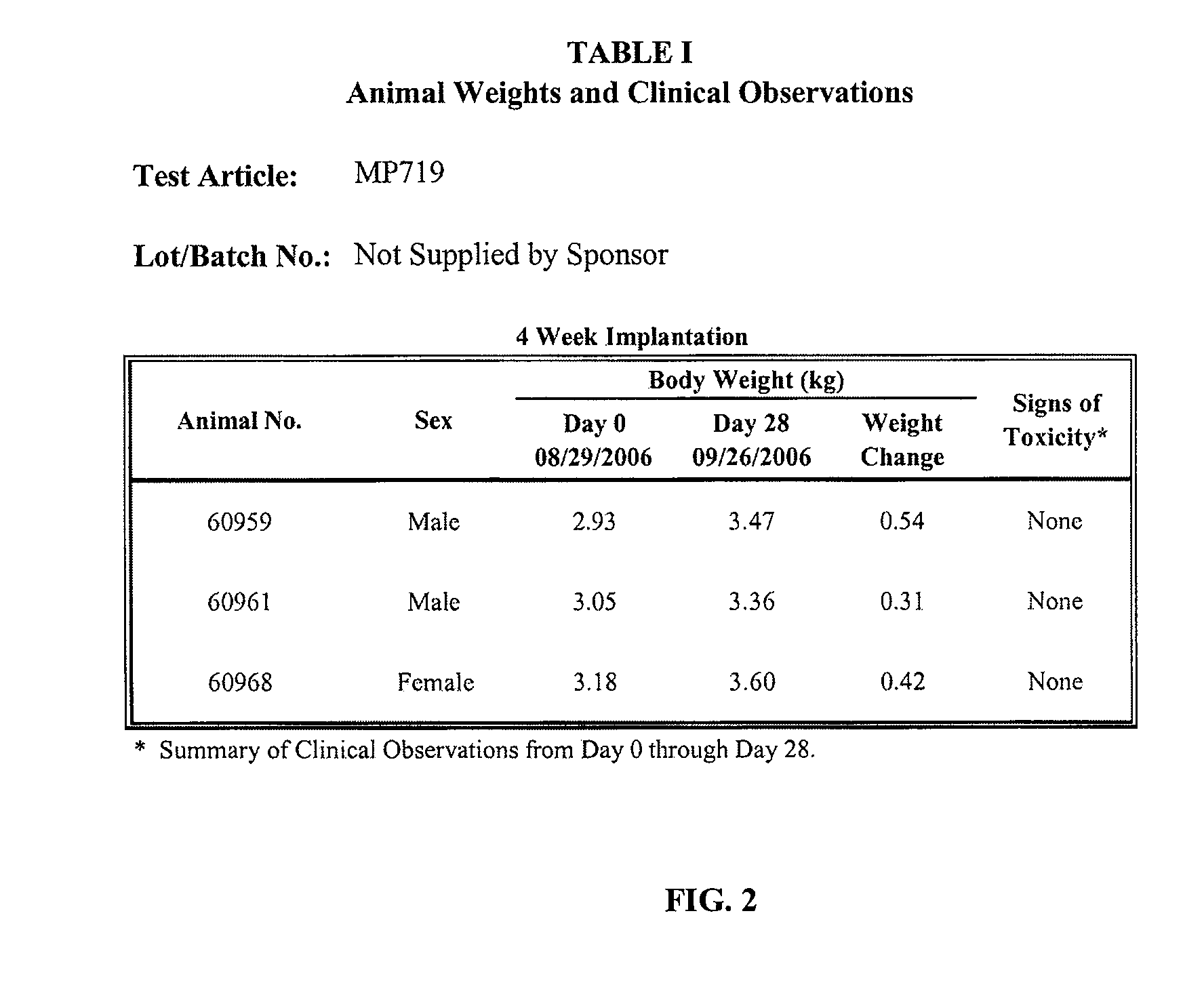Application of polymeric materials to screens to facilitate hemostasis and wound healing
- Summary
- Abstract
- Description
- Claims
- Application Information
AI Technical Summary
Benefits of technology
Problems solved by technology
Method used
Image
Examples
example 1
Biocompatability of Sample Implant
[0044]The purpose of the study was to evaluate the test article for the potential to induce local toxic effects after implantation in the muscle tissue of albino rabbits. The test article, MP719, (2-4 micron poly-N-acetyl glucosamine nanofibers; Marine Polymer Technologies, Inc., Danvers, Mass.), was implanted in the paravertebral muscle tissue of New Zealand White rabbits for a period of 4 weeks. The test article was evaluated separately using two control articles, Sponsor-specified Surgicel and Negative Control High Density Polyethylene (Negative Control Plastic). The results indicated that the test article was non-reactive when implanted for 4 weeks (Bioreactivity Rating of 0.2) when compared to Surgicel; and non-reactive (Bioreactivity Rating of 0.0) when compared to Negative Control High Density Polyethylene (Negative Control Plastic)
[0045]The study was conducted based upon the following references: ISO 10993-6, 1994, Biological Evaluation of M...
example 2
Diabetic Mouse—Granulation Tissue Measurements
[0081]Homozygous, genetically diabetic 8-12 week-old, Lep / r-db / db male mice (strain C57BL / KsJ-Leprdb) were caged separately. Food and water were given ad libitum under an approved animal protocol in an AAALAC accredited facility. One day prior to surgery, dorsal hair was clipped and depilated (Nair®, Church & Dwight Co., Princeton, N.J.). Animals were weighed and anesthetized with 60 mg / kg Nembutal (Pentobarbital) prior to surgery. The dorsum was disinfected with 70% alcohol and a 1.0 cm2 area of skin and panniculus carnosus was excised creating a full-thickness dorsal excisional wound. Wounds edges were protected with a 0.5 cm wide and 0.2 cm thick DuoDERM® (DuoDERM®, CGF®, ConvaTec, Squibb & Sons, L.L.C.) frame and dressing changes were performed on days 2 and 4. On day 7, animals were euthanized, and the wound area with its surrounding skin and underlying tissue was excised en block. The other half was fixed en block in 10% neutral-bu...
example 3
Hemostatic Effect & Synergy with Negative Pressure
[0090]A 63-year-old female with hypertension, type 2 diabetes, and end-stage renal failure requiring dialysis (BMI 300 pounds and measuring 5 feet 4 inches) presented with a large mass along the lateral region of her left hip and thigh. Diagnosis at that time was undifferentiated sarcoma involving the left lateral soft tissues from the pelvis caudad to the iliac crest up to the distal one third of the thigh. The selected course of treatment involved external beam radiation followed by surgical resection.
[0091]Administering radiation therapy prior to surgical resection provides several potential benefits including reduced tumor volume and seeding during surgical manipulation and improved overall survival. However, the incidence of wound complications has been reported to be two-fold higher after preoperative compared with postoperative radiation therapy and such complications have been shown to have detrimental effects on patient func...
PUM
| Property | Measurement | Unit |
|---|---|---|
| Time | aaaaa | aaaaa |
| Time | aaaaa | aaaaa |
| Time | aaaaa | aaaaa |
Abstract
Description
Claims
Application Information
 Login to View More
Login to View More - R&D
- Intellectual Property
- Life Sciences
- Materials
- Tech Scout
- Unparalleled Data Quality
- Higher Quality Content
- 60% Fewer Hallucinations
Browse by: Latest US Patents, China's latest patents, Technical Efficacy Thesaurus, Application Domain, Technology Topic, Popular Technical Reports.
© 2025 PatSnap. All rights reserved.Legal|Privacy policy|Modern Slavery Act Transparency Statement|Sitemap|About US| Contact US: help@patsnap.com



